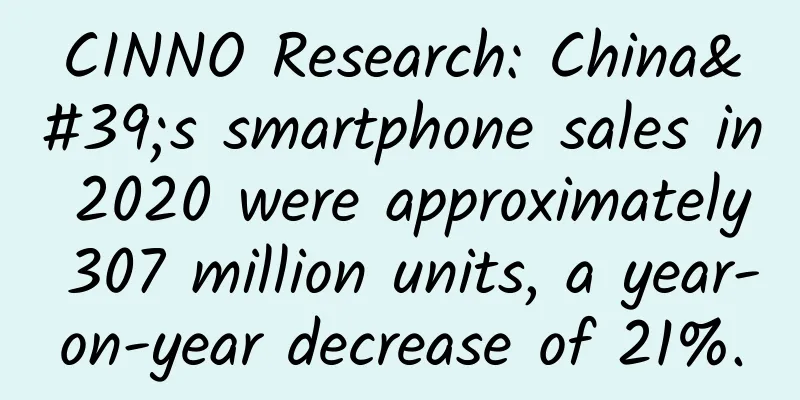CINNO Research: China's smartphone sales in 2020 were approximately 307 million units, a year-on-year decrease of 21%.

|
2020 is an extraordinary year. The epidemic at the beginning of the year and the complex international trade situation have put the entire consumer electronics industry through a huge test. According to CINNO Research's monthly domestic mobile phone sales monitoring data, the sales of smartphones in the Chinese market in 2020 were about 307 million units, a year-on-year decrease of 21%. This is the fourth consecutive year of sales decline since the first drop in domestic smartphone sales in 2017, falling to the lowest point in domestic smartphone sales in the past six years. This is mainly due to the negative impact of the epidemic on the one hand, and the lack of stimulation on the market demand side due to the technological innovation of 5G-based smart phone terminals on the other hand, resulting in delayed market demand. We predict that the demand for China's smart phone market will pick up in 2021, with sales reaching 336 million, a year-on-year increase of 9.4%. If the future international trade environment is favorable for the recovery of the industrial chain and the development of 5G commercialization is promoted, China's smart phone market will usher in a sustained upward cycle. 1. Huawei divests Honor, the brand structure will be adjusted in 2021, and Xiaomi and Apple are expected to rise In 2020, the top three sales in China's smartphone market were Huawei (including Honor), vivo (including IQOO), and OPPO. Their total sales accounted for 70% of the domestic smartphone market share. Data source: CINNO Research Monthly China Smartphone Sales Report From the sales volume and market share of each brand: 1.1 Huawei (including Honor) sold 114 million smartphones. Affected by the US ban, Huawei's total sales fell by 24%, but it still ranked No. 1 in China's smartphone sales in 2020, with a market share of 37%, a year-on-year decrease of 1.5 percentage points. Honor's sales accounted for 41%, reaching 46.64 million units, with a market share of 15%. After Huawei split Honor, China's smartphone market will present a new pattern in 2021; 1.2 The sales of vivo (including IQOO) and OPPO smartphones were 52.27 million and 47.84 million, down 24% and 25% year-on-year, respectively. Their market shares were 17% and 15.6%, which were the same as last year. 1.3 Xiaomi's smartphone sales volume was approximately 37.82 million units, down 9% year-on-year, with a smaller decline than other major domestic brands. Its market share was 12.3%, up 1.6 percentage points year-on-year. In the second half of 2020, Xiaomi's performance was particularly strong, with sales volume increasing by 23% year-on-year against the trend. Among them, Redmi sales volume increased by 37% year-on-year, mainly benefiting from the good market performance of 10X, K30 and other series of models; 1.4 Apple's smartphone sales volume was approximately 37.51 million units, ranking fifth slightly lower than Xiaomi, with a year-on-year growth of 9%. It was the only brand with positive year-on-year sales growth among the top 5 brands, with a market share of 12.2%, a year-on-year increase of 3.3 percentage points. This was mainly due to Apple's participation in large-scale price reduction promotions this year to stimulate the market. At the same time, the new generation of Apple mobile phones launched this year performed well in the market. The total sales of the iPhone 12 series models in the first month and the second month of their launch were much higher than those of the Huawei Mate40 series launched in the same period. Apple is gradually seizing Huawei's high-end market share. 2. The strong growth momentum of 5G smartphones will drive the continued increase in smartphone sales Since the launch of the first domestic 5G mobile phone, ZTE AXON 10 Pro 5G, in the third quarter of 2019, the upgrade of 5G smartphones has officially begun. In 2020, 5G smartphone sales in the Chinese market accounted for 41%, a year-on-year increase of 38 percentage points, which is basically consistent with the forecast data in CINNO Research's July mobile phone report that "the annual 5G smartphone penetration rate is expected to reach 40%." 5G smartphones accounted for 80% of the new smartphones launched in 2020, of which 5G new smartphones in the third quarter accounted for 83%, a significant increase of 59 percentage points from 24% in the same period last year. In the future, the price reduction of 5G mobile phones and the reduction of 5G tariff packages will accelerate the popularization of 5G smartphones. It is expected that the penetration rate of 5G smartphones in the Chinese market will reach 96% in 2024. 3. The price of rigid OLED screens has dropped, and flexible screens have accelerated their penetration into high-end markets, driving a steady increase in the share of OLED smartphones In 2020, OLED smartphone sales accounted for 40% of the Chinese market, up 6 percentage points from 34% in 2019. This was mainly due to Samsung's aggressive pricing strategy for rigid OLED mobile phone panels, which pushed the price of rigid OLED panels to continue to penetrate into mid- and low-end smartphones. At the same time, flexible OLED screens are accelerating their penetration into high-end flagship models of various brands. Apple's new generation of models are all equipped with flexible OLED panels. In the second half of 2020, the penetration rate of flexible smartphones rose sharply from 9% in the first half of the year to 19%, a year-on-year increase of 10 percentage points, and the share of OLED smartphones has steadily increased. With the continuous release of OLED production capacity and the development of technologies such as folding screens, the penetration rate of OLED smartphones will continue to rise in the future. 4. Sales of models with a size of 6.5″ or above have increased significantly to more than half, and foldable screens may become a new driving force for the growth of mobile phone size In addition to the upgrade of screen technology, the change of screen form is also a major highlight of the development of smartphone technology in 2020. In 2020, the share of smartphones in the 6.5” and above size range in the Chinese market increased significantly from 22% in 2019 to 54%, accounting for more than half, and the share of the 6.0”-6.5” size range decreased to 42%. The share was gradually taken over by the 6.5” and above size range, and the share of the 6.0” and below size range decreased to 4%. In October 2016, the launch of Xiaomi MIX ushered in the era of full-screen smartphones. Since then, the screen utilization rate has continued to increase. In 2019, the share of 19.5:9 full-screen smartphones in the Chinese market increased significantly from 13% in 2018 to 57%, and the share of 20:9 full-screen smartphones increased significantly from 3% in 2019 to 39% in 2020, and the penetration rate of full-screen smartphones is as high as 99%. Limited by the size of smartphones, the growth rate of average screen size will slow down in the short term, and the continuous development of technologies such as folding screens and curved screens may become a new driving force for the growth of screen size. 5. FHD/FHD+ resolution has become the mainstream, and 90Hz+ high refresh rate has become a new breakthrough in screen improvement From 2015 to 2018, the display effect of smartphone screens in the Chinese market was mainly improved by improving screen resolution. The penetration rate of FHD/FHD+ resolution increased from 34% in 2015 to 71% in 2020. Since 2019, leading manufacturers have begun to seek breakthroughs in how to increase screen refresh rates. In 2020, the sales share of smartphones with 90Hz+ screen refresh rates in the Chinese market increased from 1% in 2019 to 20%, an increase of 19 percentage points year-on-year. High screen refresh rates are becoming more and more popular in the market. Among smartphones equipped with high refresh rate screens, 90Hz and 120Hz are the main ones, accounting for 11% and 7% respectively; smartphones with 144Hz screen refresh rates entered the market in the second quarter of 2020, accounting for 2%. 6. Front and rear fingerprint sensors have gradually withdrawn from the market. In the future, under-screen fingerprint recognition and side fingerprint recognition technologies will become the mainstream of smartphones. From 2015 to 2018, the penetration rate of smartphones equipped with fingerprint recognition technology gradually increased, while the penetration rate of smartphones without fingerprint recognition continued to decline, mainly due to the continuous increase in the penetration rates of front and rear fingerprint recognition; starting from 2019, the penetration rates of front and rear fingerprint recognition technologies began to decline sharply. With the maturity of OLED under-screen fingerprint recognition technology, the proportion of under-screen fingerprint recognition has increased rapidly. The penetration rate of under-screen fingerprint recognition technology has increased from 28% in 2019 to about 35% in 2020, an increase of 7 percentage points, a significant increase. In 2020, the penetration rate of side fingerprint recognition increased to 18%, a year-on-year increase of 16 percentage points. It is expected that under-screen fingerprint recognition and side fingerprint recognition technologies will become the mainstream of smartphones in the future. 7. Flexible OLED screens will accelerate their penetration into the high-end market, and the external touch screen market opportunities are still in OLED From 2015 to 2019, the penetration rate of In-Cell touch technology for LCD screens continued to grow, while external touch technology for LCD screens gradually withdrew from the mid- and low-end markets. As the penetration rate of OLED screens further increases in the future, the penetration rate of flexible OLED screen smartphones with external touch technology and On-Cell touch technology will increase to 12% and 6% respectively in 2020. According to the sales of smartphones equipped with touch technology, the penetration rate of In-Cell touch technology for LCD screens reached 44% in 2020, of which Huawei (including Honor) smartphones accounted for the largest proportion, followed by vivo and OPPO, while the sales of LCD screens equipped with external touch technology in 2020 were almost all Apple smartphones. In 2020, the proportion of OLED screen smartphones equipped with On-Cell touch technology in China's smartphones increased to about 29%, and the sales rankings of brands were Huawei (including Honor), vivo and OPPO; Apple smartphones accounted for the largest proportion of external touch technology equipped with OLED screens, followed by Huawei (including Honor) smartphones. 8. In 2020, the area of glass cover used in smartphones in China declined for the first time, down 12% year-on-year. With the development of 5G smartphones, the penetration rate of smartphones equipped with glass cover panels (both the front cover and the back cover are made of glass) increased to 69% in 2020, an increase of 13 percentage points year-on-year. As the shipment volume of smartphones with screens of 6.0 inches and above has increased significantly in the past two years, the penetration rate of smartphones with glass covers of 6.5 inches and above has exceeded half by 2020. The only way for the size of mobile phones to continue to increase is with the help of emerging large-screen products such as folding screens. Therefore, affected by the epidemic, the area of glass covers used in smartphones in China declined for the first time in 2020, down 12% year-on-year. CINNO Research predicts that due to the limitation of smartphone screen size, the growth rate of screen size will slow down in the short term in the past two years, and the development of full-screen smartphones has come to an end. The total area of glass cover panels of smartphones in China will continue to grow slightly in the next few years.
|
<<: Guild: 41% of Brits use WhatsApp at work
Recommend
40 days after delivery, the lochia is yellow
Under normal circumstances, a woman's vagina ...
Can I have a natural birth if I have too much amniotic fluid?
During the prenatal check-up in the late pregnanc...
How many days will the menstrual period be delayed?
Many female friends have irregular menstruation f...
How to arrange diet during menstruation
During menstruation, female friends need to pay a...
What does dark areola color mean? These four possibilities
There are four most common reasons for dark areol...
What is menstrual diarrhea?
In daily life, some women will experience abnorma...
Causes of calf pain in pregnant women
Pregnant women are vulnerable to certain diseases...
Why do nipples itch occasionally?
It is quite common for nipples to occasionally it...
Which pregnant women are prone to early birth?
Pregnant women may occasionally experience some a...
Bacterial urethritis in women
Bacterial urethritis in women is a relatively com...
How deep is the vaginal embolization of compound metronidazole
The ornidazole contained in the spinosad metronid...
How to deal with white spots on nipples
Breastfeeding mothers will encounter such problem...
Do you need to be woken up during craniotomy? What is the purpose of this?
Author: Han Ruquan, Chief Physician, Beijing Tian...
Can women still get reconnected after having a vasectomy?
Can female sterilization still be effective? Two ...
Why do my legs hurt during my period?
I believe that most female friends are very famil...









